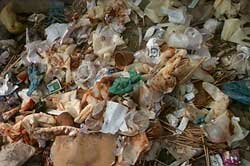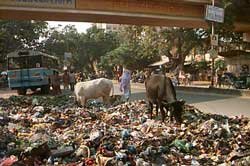|
KANPUR: This may sound a paradox. Most of the hospitals in Kanpur which are supposed to ensure better health to people have instead turned into breeding grounds for infectious diseases. Highly hazardous and infectious biomedical waste comprising contaminated needles, human anatomical waste, waste from culture and laboratory, body fluids, plasters, discarded medicines, cotton and dressings continue to be dumped in the backyard of these hospitals indiscriminately. And even though the Bio-Medical Waste (Management and Handling) Rules, 2000 makes it mandatory for all hospitals to adopt biomedical waste management system by December 31, 2002, there is no seriousness being shown by the authorities concerned including doctors, Kanpur Nagar Nigam and the Uttar Pradesh Pollution Control Board (UPPCB) to take stock of the deplorable scenario.
In Kanpur, there are 410 government/semi government, private nursing homes/ hospitals and defence hospitals which generate around 3,550 kilogram of medical waste every day. According to the Bio-Medical Waste (Management and Handling) Rules, 2000, the hospitals should collect incinerable waste such as human body waste and waste from lab cultures in yellow plastic bags and wastes like discarded needles and syringes in red plastic bags. But not a single hospital, public or private, has adopted any segregation practice. Said Central Pollution Control Board (CPCB) scientist V K Shukla, “There is a lack of awareness about the segregation of waste, which makes all waste infectious. He added that many government hospitals are reluctant to take care of their biomedical waste due to administrative hiccups.
As a result of an absence of waste management system, the unsegregated waste is piled in the hospital campus and thrown recklessly at the dumping sites. At the dumping sites, the highly infectious medical waste gets mixed with the domestic waste and makes the entire dumpyard a hotbed of diseases like HIV, Hepatitis B, Leptospira, skin problems and allergies.
 Making mockery of the biomedical waste management system, the incinerator at the Murarilal Chest Hospital is lying like a white elephant. An official, on the condition of anonymity, revealed that 25 kilogram of medical waste is generated every day from the hospital which has a capacity of 129 beds. This waste is dumped in the premises and is taken away by the contractor to an unknown destination. The waste from the adjoining Cardiology department, where highly sensitive patients are treated, is also dumped out in the open and burnt with impunity, thereby aggravating the problem of the patients. Similarly, in Lala Lajpat Rai (LLR) hospital, there is rank callousness in handling the hospital waste. One can see plasters, blood soaked bandages, body fluids, waste sharp and soiled cottons accumulated at a place where vulnerable children play. LLR, which generates 40 kilograms of biomedical waste daily, has an incinerator which incinerates only 10 per cent of the waste produced which includes non-incinerable materials also such as plastic. Making mockery of the biomedical waste management system, the incinerator at the Murarilal Chest Hospital is lying like a white elephant. An official, on the condition of anonymity, revealed that 25 kilogram of medical waste is generated every day from the hospital which has a capacity of 129 beds. This waste is dumped in the premises and is taken away by the contractor to an unknown destination. The waste from the adjoining Cardiology department, where highly sensitive patients are treated, is also dumped out in the open and burnt with impunity, thereby aggravating the problem of the patients. Similarly, in Lala Lajpat Rai (LLR) hospital, there is rank callousness in handling the hospital waste. One can see plasters, blood soaked bandages, body fluids, waste sharp and soiled cottons accumulated at a place where vulnerable children play. LLR, which generates 40 kilograms of biomedical waste daily, has an incinerator which incinerates only 10 per cent of the waste produced which includes non-incinerable materials also such as plastic.
 In Ursala Horseman Memorial (UHM) Hospital the situation is even worse. The installed incinerator costing Rs 48 lakh remains incomplete and unfunctional. The incinerator has hit a roadblock as the hospital has ran out of funds to afford a scrubber to control smoke emission. A sweeper at the site where medical waste was being burnt in the hospital disclosed that used bandages and contaminated cotton are collected by rag pickers and put to use for making quilts and cushions mostly by tent houses. Not just this, the sweepers also disclosed that a biomedical waste racket flourishes here. The racket goes somewhat like this: the ragpickers pick and sell the sorted out waste which have a resale value viz. disposable syringe, tubes, needles to the shopkeepers. The shopkeepers, in turn, sell it to contractors who repack the discarded products and supply it to different parts of the country. In Ursala Horseman Memorial (UHM) Hospital the situation is even worse. The installed incinerator costing Rs 48 lakh remains incomplete and unfunctional. The incinerator has hit a roadblock as the hospital has ran out of funds to afford a scrubber to control smoke emission. A sweeper at the site where medical waste was being burnt in the hospital disclosed that used bandages and contaminated cotton are collected by rag pickers and put to use for making quilts and cushions mostly by tent houses. Not just this, the sweepers also disclosed that a biomedical waste racket flourishes here. The racket goes somewhat like this: the ragpickers pick and sell the sorted out waste which have a resale value viz. disposable syringe, tubes, needles to the shopkeepers. The shopkeepers, in turn, sell it to contractors who repack the discarded products and supply it to different parts of the country.
Shockingly, medical college and its allied hospitals are draining its biomedical waste in Lower Ganga Canal which is one of the major sources of drinking water for Kanpur, revealed UPPCB regional officer Pramod Mishra. No wonder, the CPCB has already served show cause notice to the medical college for violating Bio-Medical Waste (Management and Handling) Rules, 2000. BP Shukla, the CPCB zonal officer said that the department can not take action against the errant city hospitals directly as “we route our actions through UPPCB”. The UPPCB has a poor record of taking swift action. Even after 2 years of the rules, no hospital has been taken to task by the department.
Although two biomedical waste treatment plants have come up in Bithoor and Bhaunti at the outskirts, the former one is lying defunct and the latter one is not proving to be cost- effective. “It can be economically viable only when the waste of all the hospitals and nursing homes comes to the plant, remarked Dr VK Verma, secretary of Medical Pollution Control Committee (MPCC), which has taken the responsibility of operating the Bhaunti plant. He underlined that the total bed capacity in Kanpur is around 11,100 but not even 10 per cent of the generated waste is sent to the plant. The incinerator at the MPCC plant can incinerate 10 tons of waste in 8 hours, however it runs for just three hours to burn 500 kilogram of waste brought here every day. President of Nursing Homes Association of Kanpur Naim Hamid stated that a few of the nursing homes take their hospital waste to the Bhaunti site but no government hospital brings its waste to the plant. Kanpur-based NGO EcoFriends believes that both the government and nursing homes are equally responsible for the present dismal situation of biomedical waste in Kanpur. Executive secretary of Eco Friends Rakesh Jaiswal reasons: Why are government hospitals setting up individual incinerators in thickly populated areas when there is a central biomedical waste treatment plant with adequate capacity and facility to deal with the entire biomedical waste generated by Kanpur. In addition, the advantage with this facility is that it is located at the outskirts where possibility of human exposure to toxicants like dioxins and furans is minimum? Are the government officials driven by ulterior motive to get their share of the allotted fund? He also levies charges against the nursing homes for their lackadaisical approach towards the biomedical waste problem. These nursing homes earn a fortune but can’t they part with just Rs 3.15 per bed per day to ensure the safe disposal of their biomedical waste? Jaiswal demanded punitive measures against the erring hospitals without any delay.
Undoubtedly, the biggest problem is that even the waste that comes from the hospitals at Bhaunti plant is not segregated. Unsegregated waste if incinerated releases dioxins and furans which produce irreparable damage to the environment. The MPCC blamed Uttar Pradesh Pollution Control Board (UPPCB) for the sorry state of affairs. It said that UPPCB has not issued a single notice to the hospitals which are flouting the rules. And so hospitals do not show alacrity to segregate their waste or join the MPCC plant. Refuting the allegation, UPPCB’s Pramod Mishra said that our department has asked hospitals to follow the Bio-Medical Waste (Management and Handling) Rules, 2000 but if they do not comply with them by December 31, 2002, UPPCB will shut them down. Will it really? That is the most pertinent question.
|
